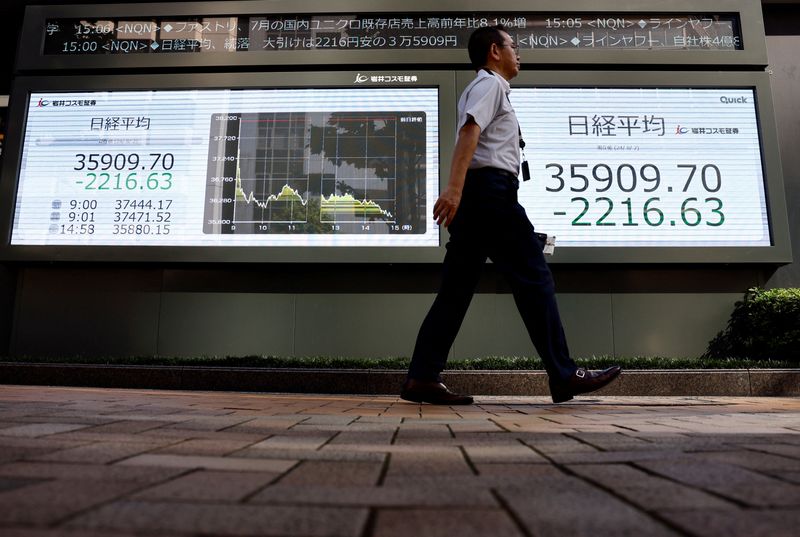By Jamie McGeever
(Reuters) – A look at the day ahead in Asian markets.
Asian markets will get their first chance on Monday to react to Friday’s extraordinary market moves, which sent stock and bond yields plunging and volatility and interest rate cut expectations soaring after an unexpectedly soft US employment report .
That “risk off” sentiment and momentum is sure to spill over to Asia, which was already reeling last week after the Bank of Japan’s aggressive policy shift, even slower Chinese economic data and some weak U.S. tech earnings.
The stock index fell 2.5% on Friday, the biggest decline in more than two years, and Japan’s fell 5.8% for the biggest decline since March 2020. Japan’s broader 6.1% decline marked the worst day since 2016.
Given Friday’s US payrolls-driven sell-off on Wall Street, a sharp sell-off in Asia is likely early Monday. Friday’s market swings may prove to be excessive, but they are worth noting.
Two-year US Treasury yields fell 30 basis points, the steepest one-day drop since the US regional bank shock in March last year. The weekly decline of 50 basis points matches that of the COVID-19, Lehman, 9/11 and Black Monday crises.
In equities, the volatility index at one point on Friday doubled compared to the day before.
The rush to unwind carry trades helped the yen rise nearly 5% against the dollar last week; the Japanese currency has had only three better weeks in the past 25 years.
Falling US Treasury yields could improve financial conditions (Goldman Sachs’ emerging market financial conditions index fell to its lowest level since March on Friday), but they are easing for ‘bad’ reasons, namely fears of a recession.
Hopes for the much-vaunted American economic ‘soft landing’ appear to have been completely extinguished, replaced by fears of a ‘hard landing’.
Traders now expect a 70% chance that the Fed will cut rates by half a percentage point next month, and are anticipating an easing of 115 basis points by the end of the year and more than 200 basis points by next June.
The high yield corporate bond markets will be worth keeping a close eye on. This is where the first signs of a ‘credit event’ usually appear, heralding wider corporate retrenchment, rising unemployment and ultimately a recession.
Spreads on high-yield US government bonds versus government bonds rose to a yearly high of more than 370 basis points on Friday, but that was mainly due to the fall in government bond yields rather than investors dumping corporate bonds . If that dynamic changes, hold on to your hats.
Monday’s economic and events calendar in Asia includes index data from service sector purchasing managers from across the continent, including China, inflation figures from Thailand, GDP figures from Indonesia and some Japanese earnings.
Here are the key developments that could give markets more direction on Monday:
– China ‘unofficial’ PMI for services (July)

– Thailand consumer price inflation (July)
– Indonesia GDP (Q2)


